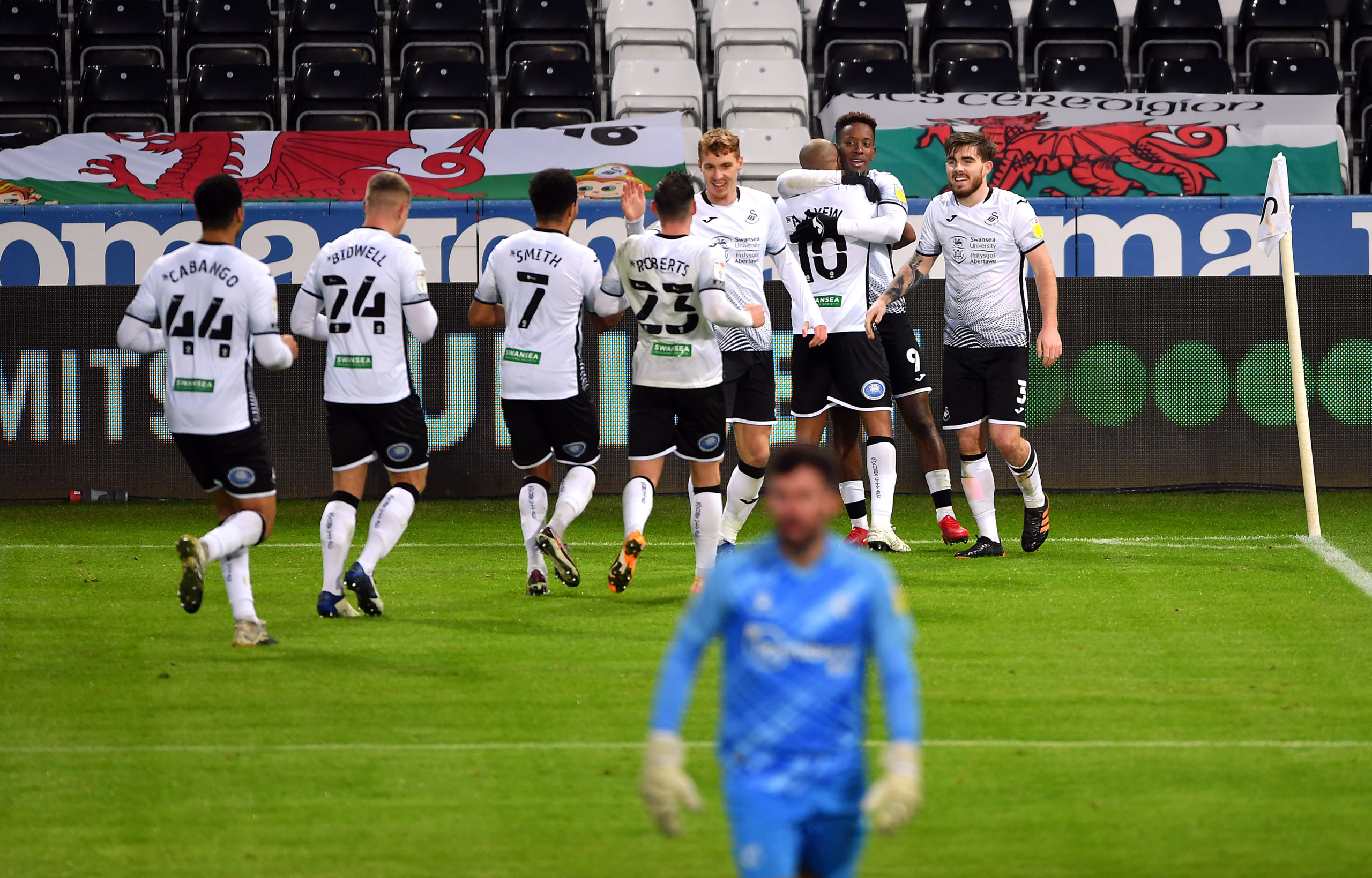As we hurtle through the midway point of this unrelenting EFL season, there's just time to quickly take stock. A top-to-bottom analysis won't be much use when it’ll all have changed within a week, so instead we’ve picked out 10 of the most interesting storylines from a typically chaotic opening half of the EFL season.
1) Swansea City Shut-Outs
Play-off semi-finalists in 2019/20, Swansea are going well once again. So well, in fact, that they’re currently on course to break a Championship record since it rebranded in 2005 for the fewest goals conceded in a league season. Preston North End’s miserly 30 concessions in 2005/06 is the yardstick to beat - The Swans’ record of 14 conceded from 25 games puts them on course.
Steve Cooper's made a clear move towards implementing a more robust defensive structure: their Aggression % - the percentage of opposition pass receipts that are tackled, fouled or pressured within two seconds – has dropped from 23% to 18%, and this new approach has paid rich dividends across every defensive metric.
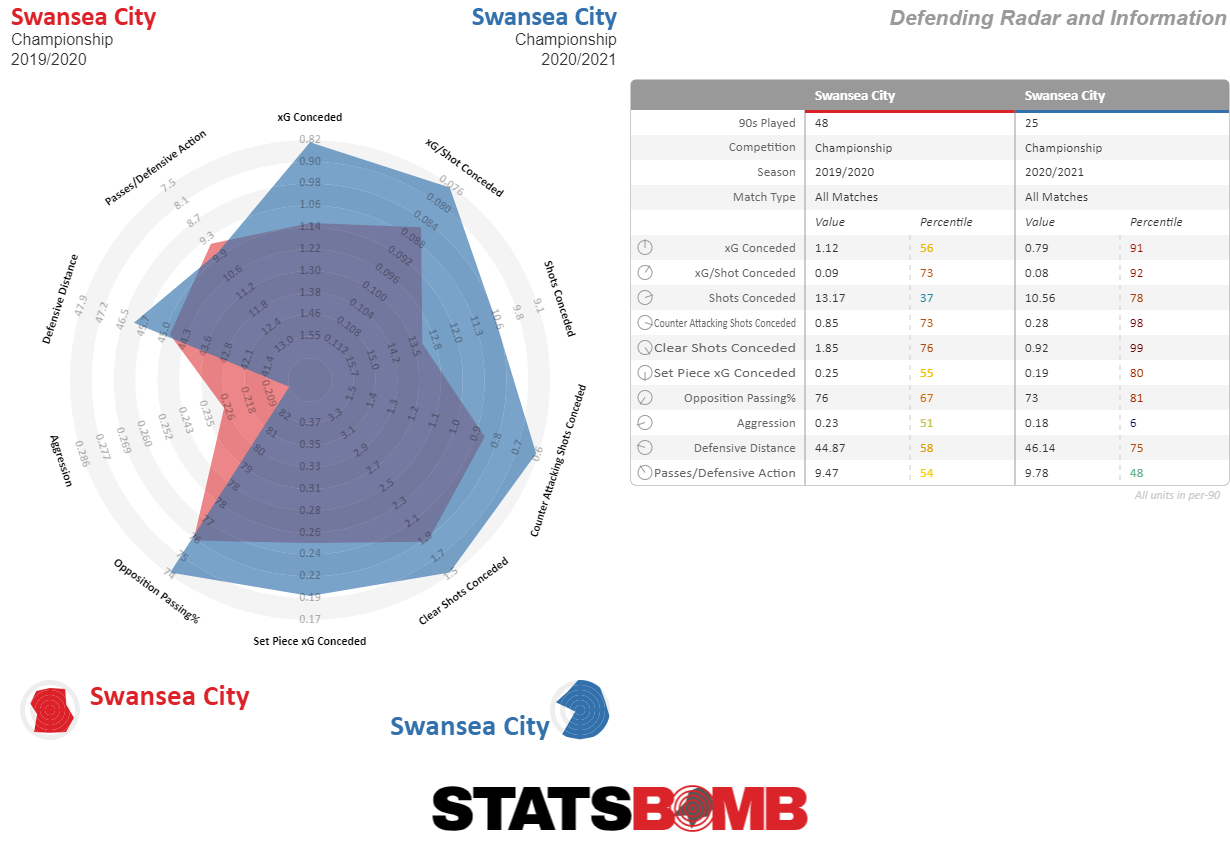
Their diligence in the defensive transition means they've conceded seven(!) counter-attacking shots all season, as well as just 22 shots that have solely the goalkeeper between ball and goal.
Simply, the team doesn’t concede valuable chances. The Swans have faced just 11 shots with an xG value greater than 0.30 all season. In laymans terms, they very rarely concede anything approaching a clear-cut chance. Such stinginess could power them all the way back to the Premier League.
2) Pressing Matters With Callum O’Hare
After a successful loan spell, securing Callum O’Hare’s services on a permanent deal was a crucial piece of summer business for newly promoted Coventry. They’ve been rewarded with an unrivalled work rate from the young attacking midfielder.
This comes as no surprise considering O’Hare led League 1 last season with a whopping 33 pressures per 90. That number is slightly down this campaign – understandable given the especially tight schedule – but relative to the Championship it’s barely noticeable. The result is that no one in the entire EFL registers more pressures per 90 than O’Hare, and in the Championship it’s not even close.
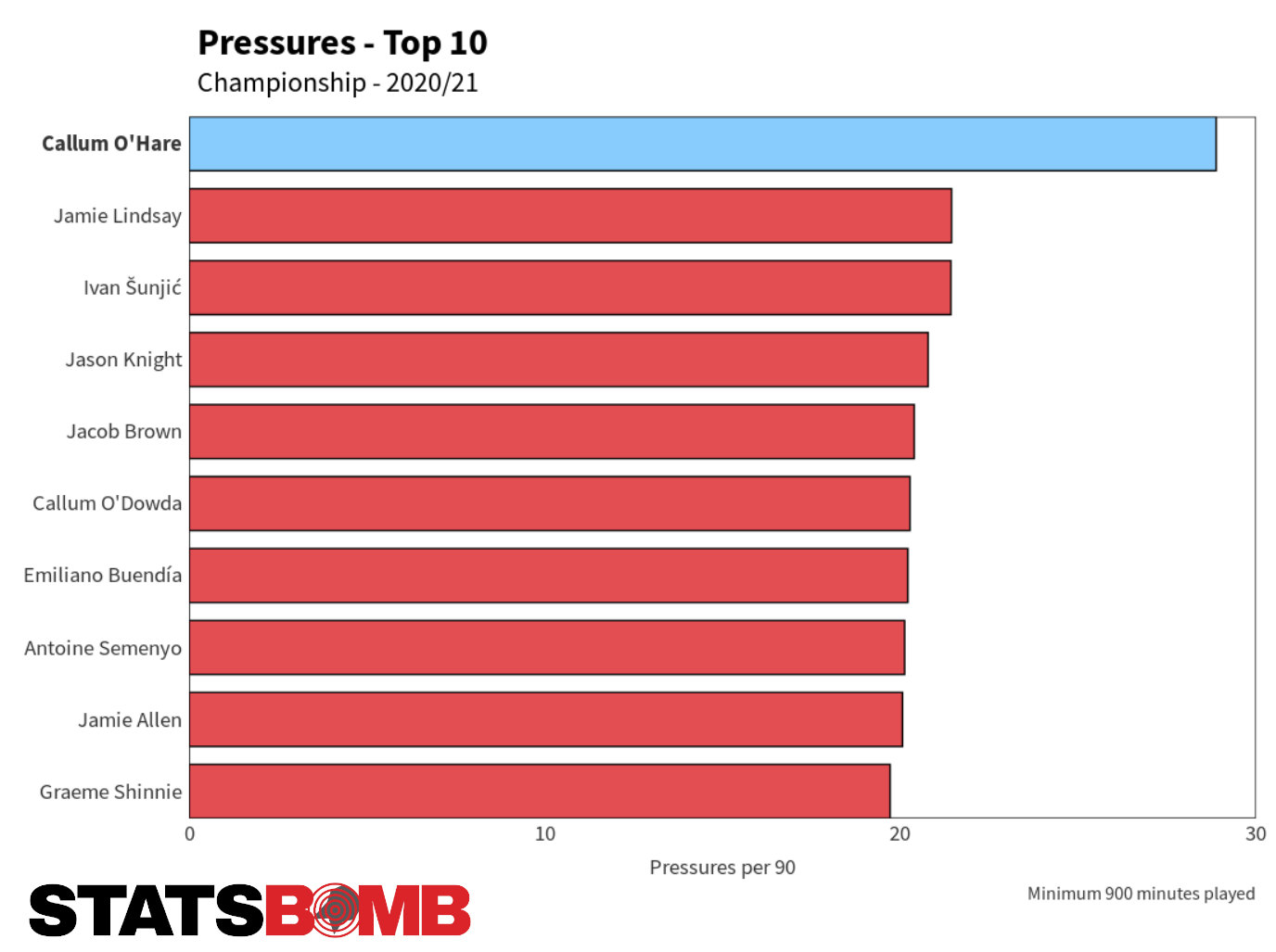
When you consider that he’s played more minutes than all-but-one of the other players in the top 10, it's even more impressive. The prolonged off-season Coventry enjoyed compared to their Championship rivals is certainly paying off for both O’Hare and the Sky Blues.
3) Has ‘The Beast’ Unlocked a New Level of Physical Dominance?
It was a different world when Adebayo Akinfenwa last appeared on the StatsBomb site back in October 2019. At that stage there was one unknown and one unlikely: the unknown was whether then-37-year-old Akinfenwa would continue playing this season, the unlikely was that Wycombe would secure promotion to the Championship for the first time in their history.
Fast-forward and here we are, with both Akinfenwa and Wycombe playing at Championship level for the first time. Bayo was never likely to turn down the opportunity to go to war with Championship centre backs, having bullied their League One and League Two counterparts in his career up to now.
Last season in League One he managed 9.7 aerial wins per 90, league-leading for players with more than 1200 minutes, but this season he’s taken that aerial dominance to a new level despite the rise in class, in what is a notoriously physical league in the Championship. His current rate of 14.6 aerial wins per 90 is the best in England’s top four divisions.
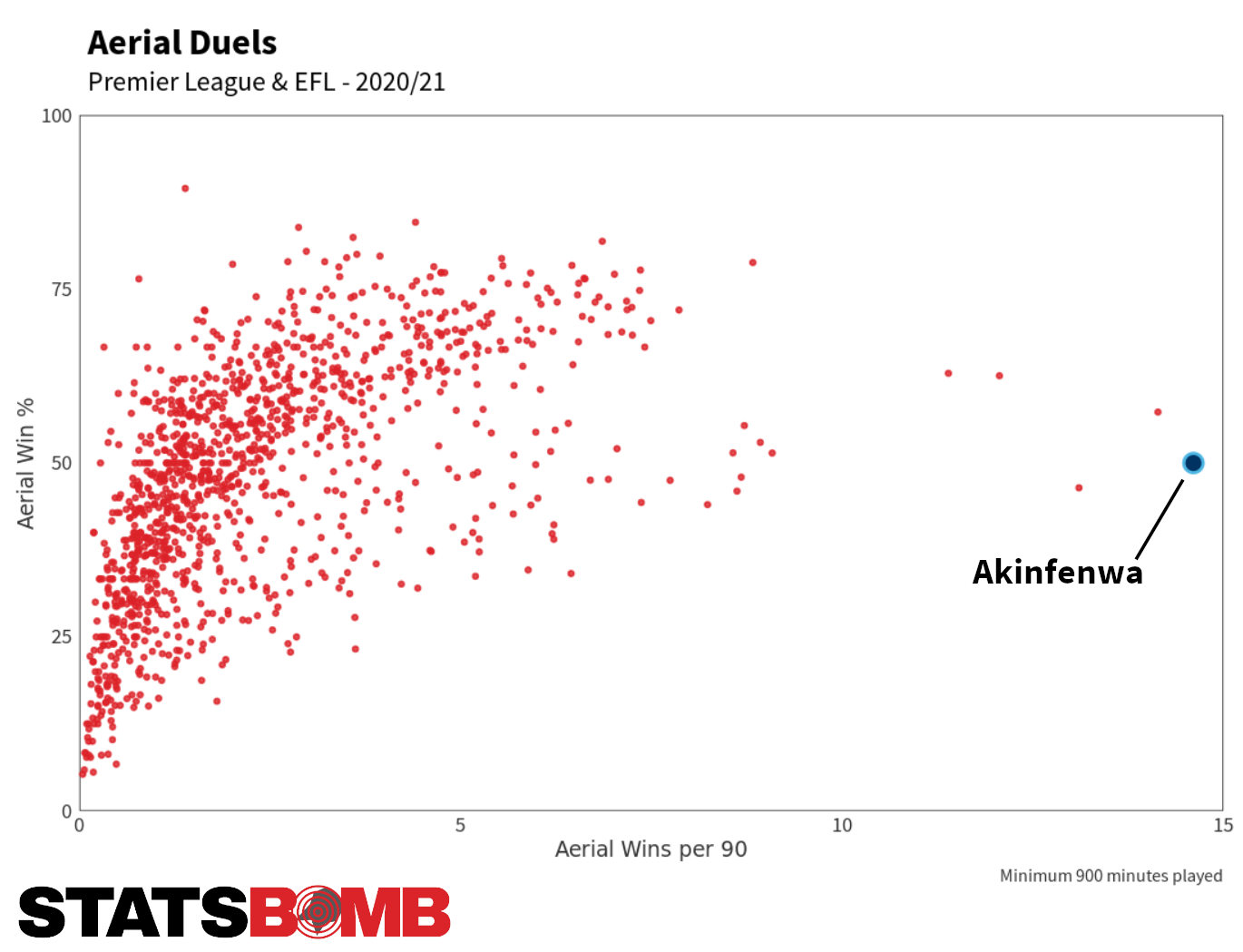
Wycombe’s not-so-secret weapon continues to provide a valuable outlet for them in making the ball stick up front. Can they and Akinfenwa together pull off an unlikely survival in the second half of the season?
4) MK Dons: Camped In Enemy Territory, But Defensively Exposed
Into League One now where MK Dons have caught the attention of the EFL audience for their possession-based style of play. They’ve gained a lot of plaudits for their ability to control the territory but, whilst being easy on the eye, they’ve struggled to convert this dominance into points, currently sitting 16th with a return of 28 points from 24 games.
There’s a real dichotomy between the process and the outcomes at Stadium MK. The Milton Keynes based side, with 52.8 Deep Progressions per 90, enter the opposition’s final third more often than any other team in League One and, once they’re there, they’re also completing more passes within 20m of goal than any other side, completing 6.4 Deep Completions per 90. However, this dominance isn’t translating into shots or good chances on goal: the Dons rank 13th in League One for both shots and expected goals created.
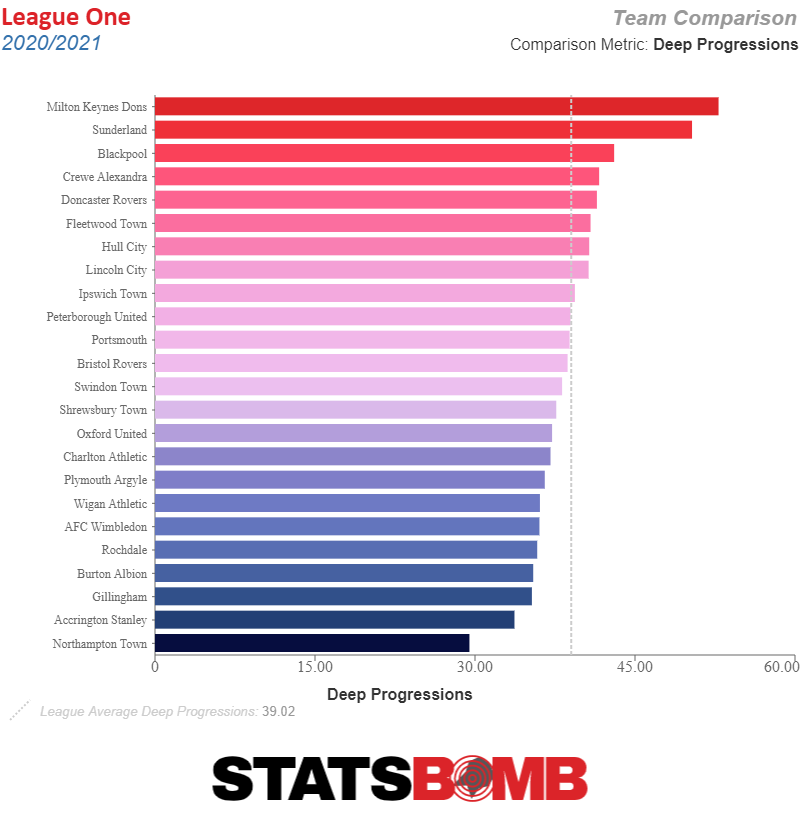
It’s a similar story at the back. MK are behind only Sunderland for both final third entries conceded and Deep Completions conceded. It’s only a good thing that the opposition are spending so little time in threatening positions, but the issue is what happens when they do break into MK Dons territory - find space and cause a lot of damage. MK’s xG per shot conceded of 0.13 is the worst in the league.
5) Josh Emmanuel: Full Back Attack
There are many great sights within the beautiful game. Surely one of the best is a player carrying the ball with power and dribbling at speeds the casual spectator could only dream of. When it comes to seeing this in the EFL, Josh Emmanuel is a stand out.
Flying up and down the wing was something Emmanuel could have done in a completely different sport having been offered trials at Saracens in Rugby Union as a youngster, but it’s now on Hull City's right flank where Emmanuel’s heels are shredding turf.
Emmanuel’s average carry length is currently the fifth-longest amongst other League One full backs and wing backs, but he’s a much more dependable outlet than those above him. His 38.7 Carries per 90 is by far the most of that group, and completed at a higher percentage than his competition too.
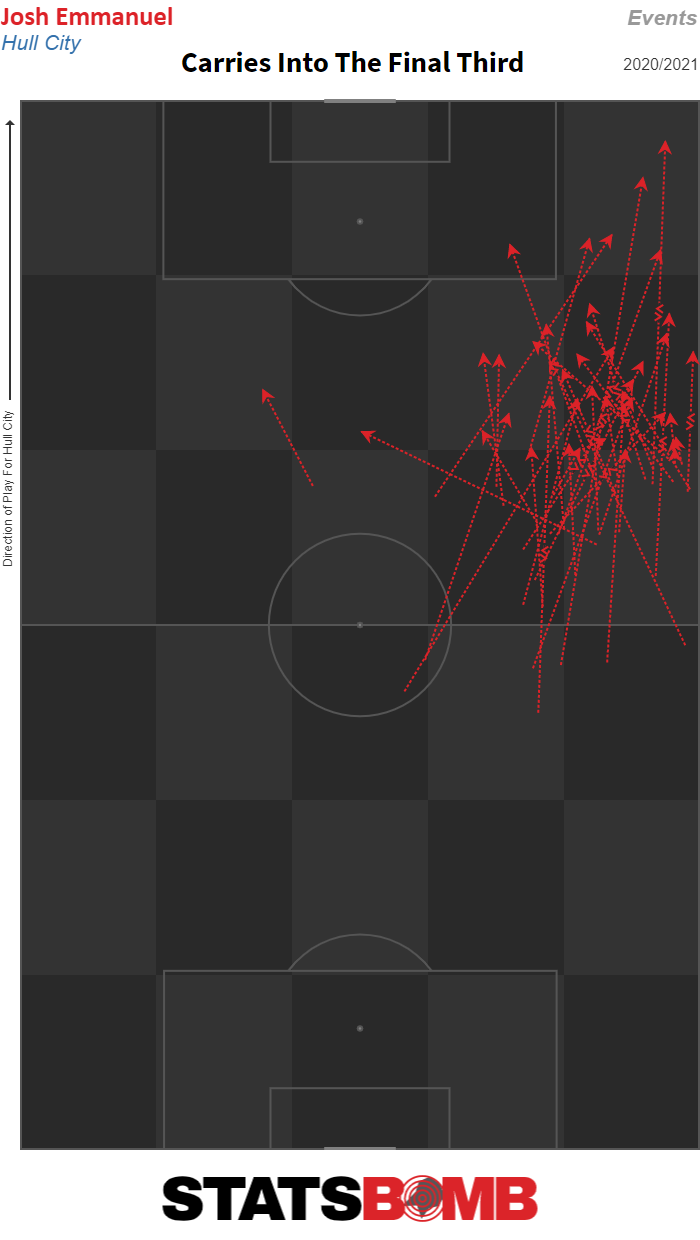
It’s not just carrying into space that he thrives in, he’s capable of taking the ball past an opponent too. Emmanuel’s completed the most dribbles of League One full backs this season and was behind only two others in 2019/20. This on-ball capability makes him a key player in the attacking phase of Hull’s game: making the second-most final third entries of his side, the third-most passes into the box, and has the third-highest xG assisted from open play.
6) Chuks Aneke: Bench Warmer, Ice Cold Finisher
A hark back to the good old days of sub-effects now.
Chuks Aneke is excelling in the role of super-sub this season. The Arsenal academy graduate has played in 20 of Charlton’s 25 games so far but made only seven starts to accumulate a total of 999 minutes - just 40% of the minutes available.
And yet…
Aneke has been absolutely smoking tired League One defences this season. Of his nine goals, just three have come in matches he’s started, the other six have come when being deployed from the bench. When he starts he scores at a rate of 0.52 goals per 90, when he comes off the bench it's 1.12 goals per 90.
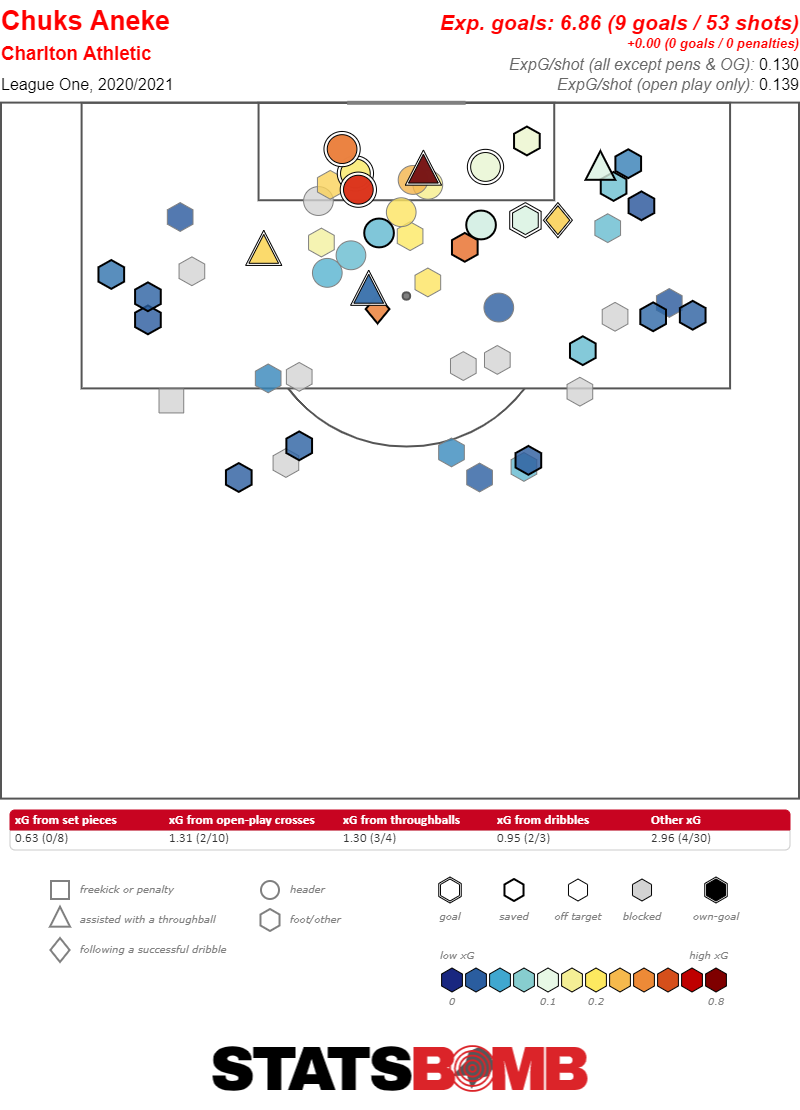
The sub-effects are real but that’s not to downplay his impact. Aneke is objectively (and subjectively) putting in some of the best forward performances in the league. Ignoring his monumental return off the bench, his contribution of 0.52 goals per 90 from the start would be the 5th best return in League One. All in, for players with at least 900 minutes played this season, Aneke is tops the league for all of Shots per 90, xG per 90, and goals per 90.
7) Max who? Max Watters
There's only one place to start in League Two and that's with probably the story of the entire EFL season up to now. Released by League One Doncaster after five forgettable appearances, Max Watters rocked up at Crawley Town in October to little fanfare, having only been spotted by the Crawley staff when playing against them in a friendly for non-league Maidstone United where he was on trial.
Three months, 15 appearances and 13 goals later, Watters was off to Cardiff City in the Championship for a reported seven-figure fee.
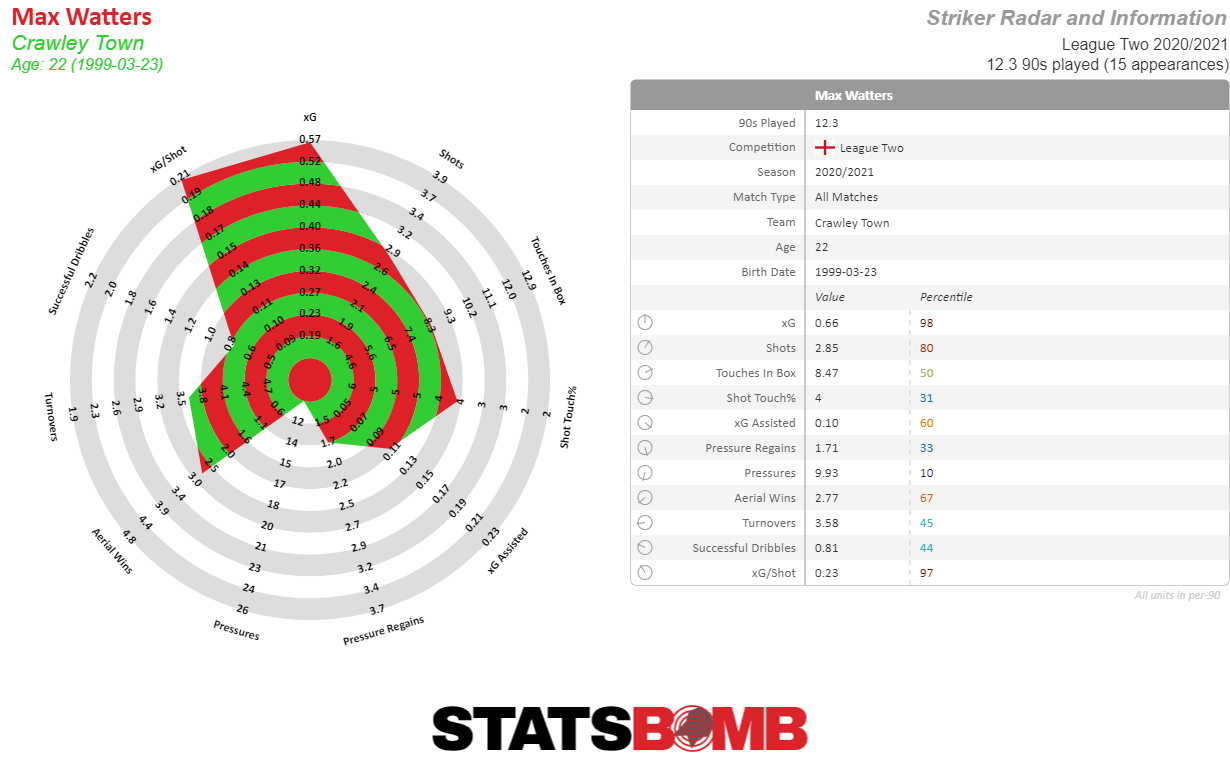
Watters was a touch ahead of his expected goals, notching his 13 goals from 8.1xG, but he repeatedly showed a nose for getting into good goalscoring positions and finishing in a variety of ways too - scoring with his left foot, right foot, or head - and with little-to-no wastage whatsoever in his shot selection. His rate of 1.06 goals per 90 was so extreme that it was nearly half-a-goal better than the next best record in League Two, and his 0.66 xG per 90 was also a clear standout ahead of the rest.
Just three months of very successful League Two football was enough to persuade Cardiff to give him an opportunity in the Championship. Returns like the ones he was making at Crawley would make the fee an absolute bargain.
8) Sunshine and Beechball in Cumbria
There were no signs in Carlisle’s unremarkable 2019/20 campaign to suggest they'd embark on a promotion push just months later, but here we are. With no discernible improvement in results, the November 2019 appointment of Chris Beech went largely under the radar last season, but behind the scenes foundations were being laid.
This season has seen a move to a style of play that pundits have christened “Beechball” – an energetic, high pressing and direct game that has brought praise for both its entertainment and its efficacy, with the Cumbrians currently top of the table by points per game.
Last season most of Carlisle’s defending was done in their own half, but this season they’re active much further up the pitch: their Defensive Distance – the average distance from a team’s own goal that it makes defensive actions – has shifted from 41.2 metres, 23rd in 19/20, to 47.4 metres, 1st in 20/21. It’s working too – Carlisle are conceding the fewest shots in the league.
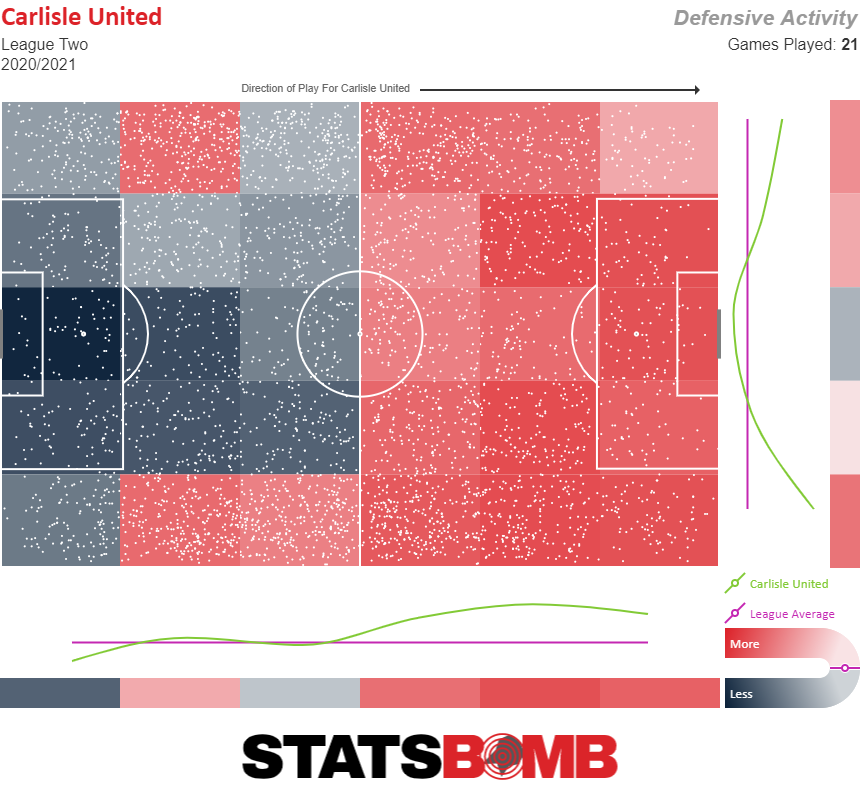
They’re also thriving in possession and pose a well-rounded threat. An average of 17.5 shots per game is the most in the league and three more than next best Newport County, and they’re generating opportunities from all phases of play. Carlisle rank 1st for counter attacking shots, illustrating their speed and threat in transition, but also rank 1st for set piece xG, with 0.48xG per 90. Significant output in this area could go a long way to helping their promotion push – creating half-a-goal a game from set plays, extrapolating to 23 goals over a full season, is a juicy cherry to put on top of the open play cake.
Even within set plays they’ve got all bases covered, creating regular chances from corners, indirect free kicks, and throw ins. The latter has been particularly noteworthy with winger Josh Kayode catapulting projectiles into the opposition penalty box at every available opportunity.
9) The Second Best Attack In The Country
Across England’s top four divisions, Exeter are second only to Liverpool for goals scored per 90 and xG created per 90. By xG per shot, they rank top.
Given the competitive balance in League Two, it’s a big surprise to see a team putting up numbers of that scale, particularly one that currently sits 9th in the table. The Devon-based club have implemented a style of play under manager Matt Taylor that sees them look to enter the box from high-value areas rather than playing into it from deeper positions. Almost all of their box entries have come once they have possession in the final third.
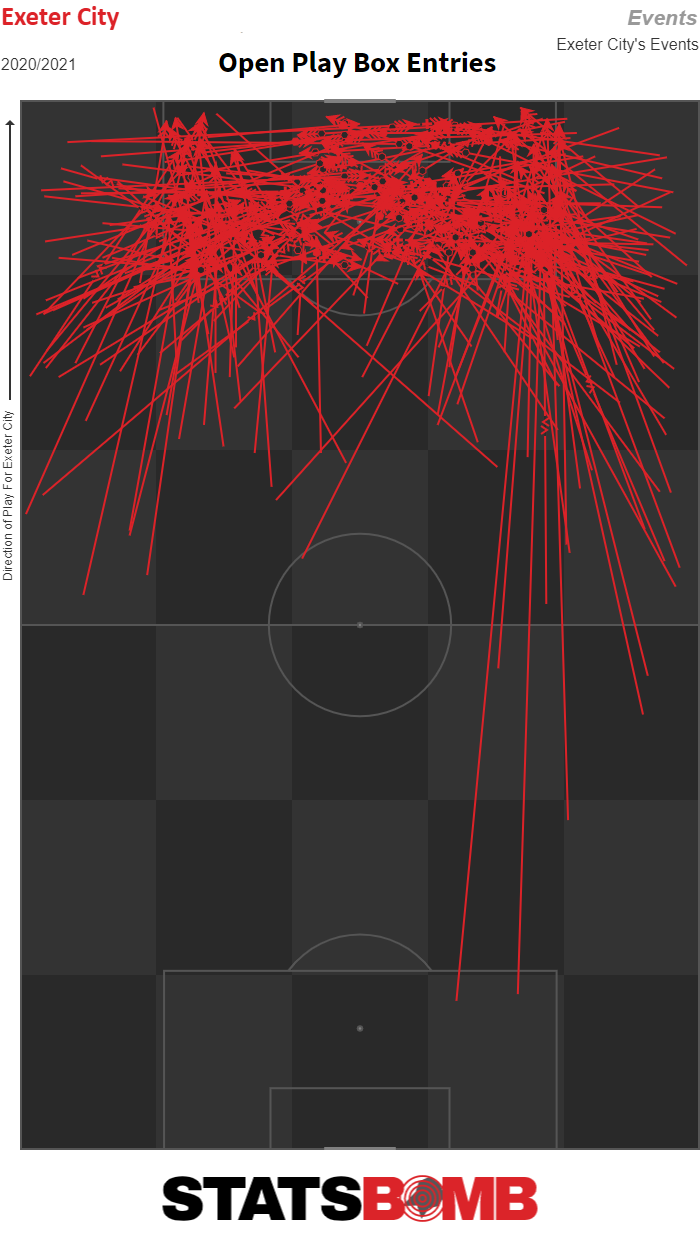
Watch an Exeter game this season and you’re guaranteed to see the ball being flashed across the face of goal or pulled back towards the penalty spot again and again.
The optimal execution of this strategy came in their November fixture at home to Colchester United, who had no answer for Exeter’s relentless probing of their penalty area. All six of Exeter’s goals that day came from within the six yard box and – typical manager interview cliché incoming – it really could’ve been even more.
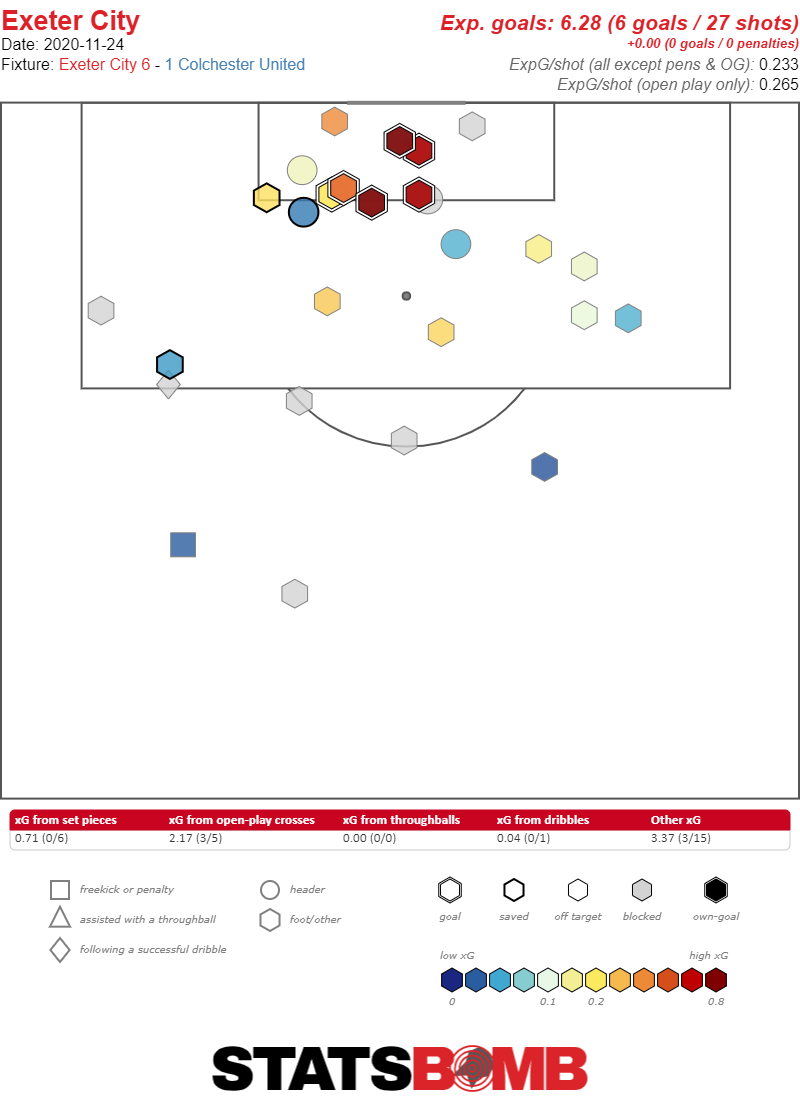
A case of blatant stat-padding, but even excluding that game Exeter still rank first in League Two for both xG created and xG per shot. Maintaining this level of creativity could see them go one better than last season’s play-off final defeat.
10) Lionel Wessi Seeing Out His Career In Cambridge
Contrary to Exeter, Cambridge take a slightly different approach to progressing the ball and getting into the opposition area. A strategy that makes total sense when you have a player of Wes Hoolahan’s – Lionel Wessi’s - skillset in your ranks.
The U’s, top of the league at the time of writing, are much more inclined to take a vertical approach through the centre of the pitch and Hoolahan’s driving runs and subsequent through balls have become a common sight at the Abbey Stadium. Even at 38, the class and quality that earned him over 100 Premier League appearances whilst at Norwich are still obvious and a major asset to Cambridge’s attacking game. You can pick out Hoolahan’s trademark slide passes through gaps in the opposition defence when looking at his open play passes into the penalty box.
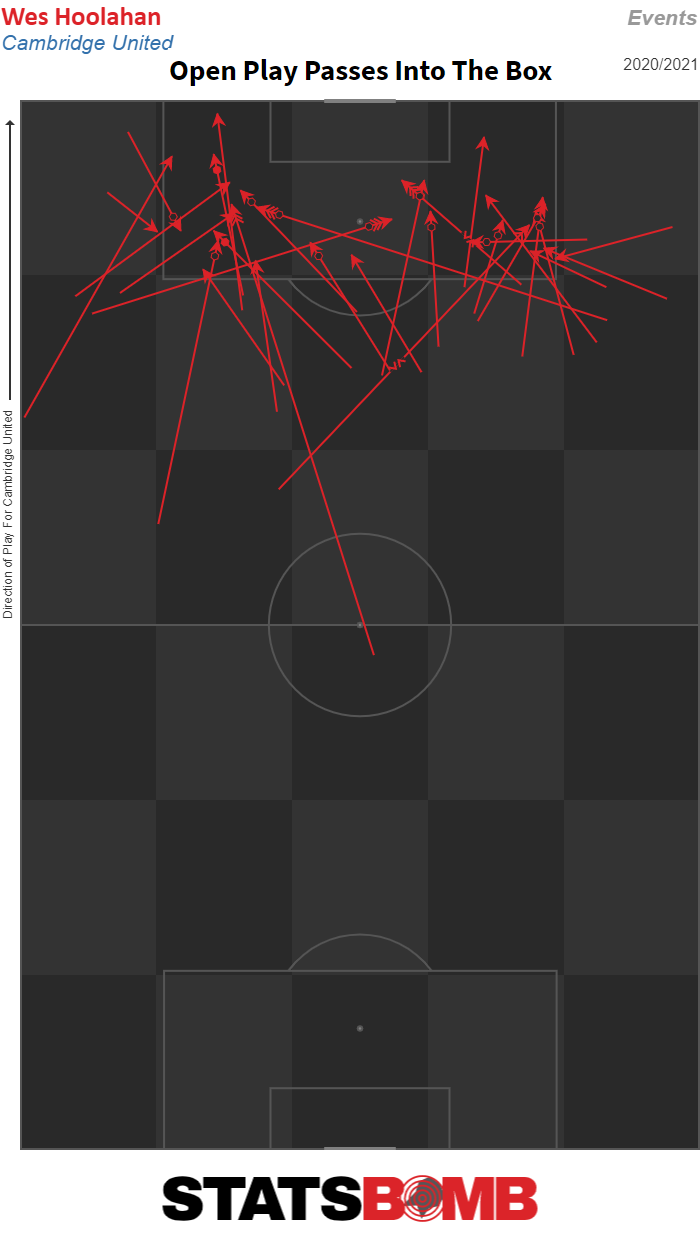
The creative spark in the midfield, on a per 90 basis Hoolahan ranks top in League Two for Carries of the ball and more importantly through balls, providing a high-class link between the middle and final third.
11) Bonus Nutmegs
Lastly, a small, nutmeg-flavoured palate cleanser now we’re at the end. Here's the top five Nutmeggers and Nutmegees of the 2020/21 EFL season. Enjoy.
Player |
Club |
Competition |
Nutmegs |
| Antoni Sarcevic | Bolton Wanderers | League Two | 8 |
| Adam Armstrong | Blackburn Rovers | Championship | 7 |
| Siriki Dembele | Peterborough United | League One | 6 |
| Scott Sinclair | Preston North End | Championship | 6 |
| Conor Wilkinson | Leyton Orient | League Two | 6 |
Player |
Club |
Competition |
Nutmegged |
| James Brophy | Leyton Orient | League Two | 5 |
| Emiliano Buendía | Norwich City | Championship | 4 |
| Oliver Rathbone | Rochdale | League One | 4 |
| Josh Laurent | Reading | Championship | 4 |
| Nathan Byrne | Derby County | Championship | 4 |
Join us at StatsBomb Evolve on March 17th 2021 to discover how we're going to change the football industry, including the launch of our new data product, StatsBomb 360. To find out more, click here.
